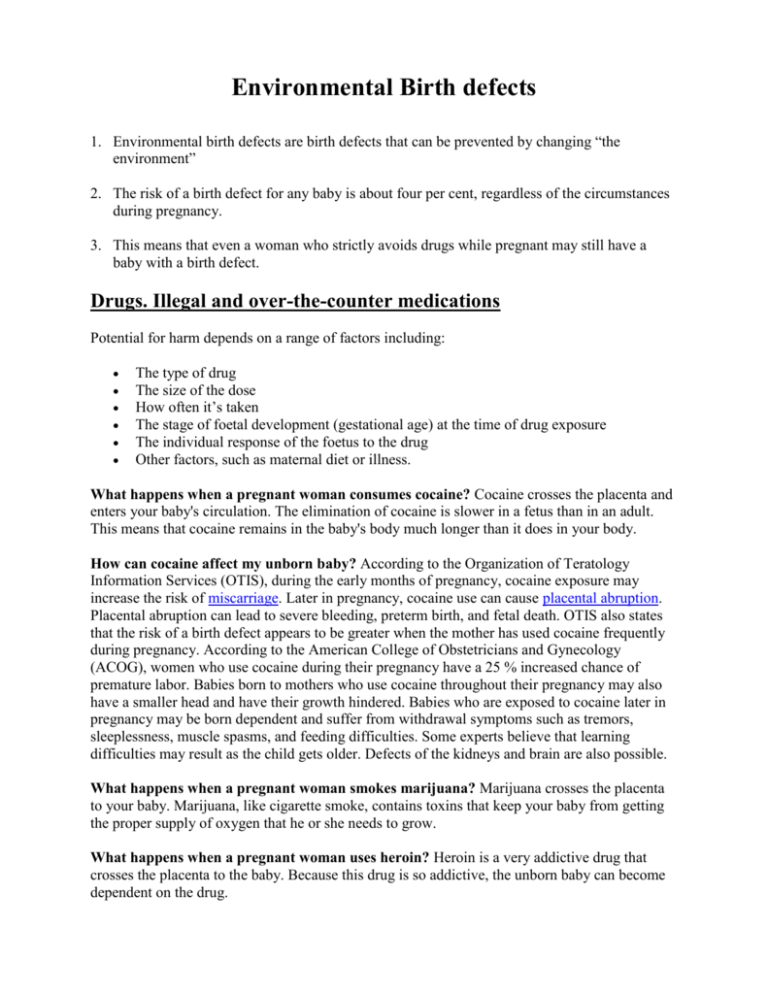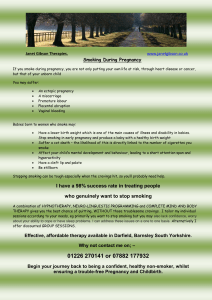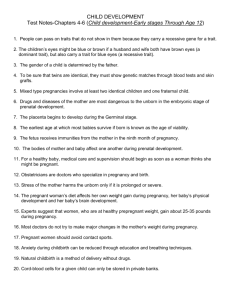
Environmental Birth defects
1. Environmental birth defects are birth defects that can be prevented by changing “the
environment”
2. The risk of a birth defect for any baby is about four per cent, regardless of the circumstances
during pregnancy.
3. This means that even a woman who strictly avoids drugs while pregnant may still have a
baby with a birth defect.
Drugs. Illegal and over-the-counter medications
Potential for harm depends on a range of factors including:
The type of drug
The size of the dose
How often it’s taken
The stage of foetal development (gestational age) at the time of drug exposure
The individual response of the foetus to the drug
Other factors, such as maternal diet or illness.
What happens when a pregnant woman consumes cocaine? Cocaine crosses the placenta and
enters your baby's circulation. The elimination of cocaine is slower in a fetus than in an adult.
This means that cocaine remains in the baby's body much longer than it does in your body.
How can cocaine affect my unborn baby? According to the Organization of Teratology
Information Services (OTIS), during the early months of pregnancy, cocaine exposure may
increase the risk of miscarriage. Later in pregnancy, cocaine use can cause placental abruption.
Placental abruption can lead to severe bleeding, preterm birth, and fetal death. OTIS also states
that the risk of a birth defect appears to be greater when the mother has used cocaine frequently
during pregnancy. According to the American College of Obstetricians and Gynecology
(ACOG), women who use cocaine during their pregnancy have a 25 % increased chance of
premature labor. Babies born to mothers who use cocaine throughout their pregnancy may also
have a smaller head and have their growth hindered. Babies who are exposed to cocaine later in
pregnancy may be born dependent and suffer from withdrawal symptoms such as tremors,
sleeplessness, muscle spasms, and feeding difficulties. Some experts believe that learning
difficulties may result as the child gets older. Defects of the kidneys and brain are also possible.
What happens when a pregnant woman smokes marijuana? Marijuana crosses the placenta
to your baby. Marijuana, like cigarette smoke, contains toxins that keep your baby from getting
the proper supply of oxygen that he or she needs to grow.
What happens when a pregnant woman uses heroin? Heroin is a very addictive drug that
crosses the placenta to the baby. Because this drug is so addictive, the unborn baby can become
dependent on the drug.
How can heroin affect my unborn baby? Using heroin during pregnancy increases the chance
of premature birth, low birth weight, breathing difficulties, low blood sugar (hypoglycemia),
bleeding within the brain (intracranial hemorrhage), and infant death. Babies can also be born
addicted to heroin and can suffer from withdrawal symptoms. Withdrawal symptoms include
irritability, convulsions, diarrhea, fever, sleep abnormalities, and joint stiffness. Mothers who
inject narcotics are more susceptible to HIV, which can be passed to their unborn children.
Alcohol Use in Pregnancy
There is no known safe amount of alcohol to drink while pregnant. There is also no safe time
during pregnancy to drink and no safe kind of alcohol. Centers for Disease Control and
Prevention urges pregnant women not to drink alcohol any time during pregnancy.
Women also should not drink alcohol if they are planning to become pregnant or are sexually
active. This is because a woman could become pregnant and not know for several weeks or
more. In the United States half of all pregnancies are unplanned.
FAS-Fetal Alcohol Syndrome is now called Fetal Alcohol Spectrum Disorder. FASDs are 100%
preventable. If a woman doesn’t drink alcohol while she is pregnant, her child cannot have an
FASD.
Why Alcohol is Dangerous
When a pregnant woman drinks alcohol, so does her unborn baby.
Alcohol in the mother’s blood passes through the placenta to the baby through the umbilical
cord. This is 100% preventable. If a woman doesn’t drink alcohol while she is pregnant, her
child cannot have a FASD.
Drinking alcohol during pregnancy can cause miscarriage, stillbirth, and a range of lifelong
disorders, known as fetal alcohol spectrum disorders (FASDs). Children with FASDs might
have the following characteristics and behaviors:
Abnormal facial features, such as a smooth ridge between the nose and upper lip (this
ridge is called the philtrum)
Small head size
Shorter-than-average height
Low body weight
Poor coordination
Hyperactive behavior
Difficulty paying attention
Poor memory
Difficulty in school (especially with math)
Learning disabilities
Speech and language delays
Intellectual disability or low IQ
Poor reasoning and judgment skills
Sleep and sucking problems as a baby
Vision or hearing problems
Problems with the heart, kidney, or bones
Smoking during pregnancy
What do we know about tobacco use and pregnancy?
Women who quit smoking before or early in pregnancy significantly reduce the risk for several
adverse outcomes.
Compared with women who do not smoke—
o Women who smoke prior to pregnancy are about twice as likely to experience a
delay in conception and have approximately 30% higher odds of being infertile.
o Women who smoke during pregnancy are about twice as likely to experience
premature rupture of membranes, placental abruption, and placenta previa during
pregnancy.
Babies born to women who smoke during pregnancy—
o Have about 30% higher odds of being born prematurely.
o Are more likely to be born with low birth weight (less than 2500 grams or 5.5
pounds), increasing their risk for illness or death.
o Weigh an average of 200 grams less than infants born to women who do not
smoke.
o Are 1.4 to 3.0 times more likely to die of Sudden Infant Death Syndrome (SIDS).
Prevalence of smoking during pregnancy
According to 2004 Pregnancy Risk Assessment and Monitoring System (PRAMS) data from 26
states—
Approximately 13% of women reported smoking during the last three months of
pregnancy.
Younger, less educated, non-Hispanic, white women and American Indian women are
more likely to smoke during pregnancy compared to their older, more educated,
counterparts.
Of women who smoked during the last three months of pregnancy, 52% reported
smoking 5 or less cigarettes per day, 27% reported smoking 6 to 10 cigarettes per day,
and 21% reported smoking 11 or more cigarettes per day.
Secondhand smoke
Exposure to secondhand smoke causes premature death and disease in children and adults who
do not smoke.
Between 1988 and 2002, cotinine levels, a biological indicator of tobacco smoke
exposure, declined by approximately 70% among children and non-smoking adults.
Despite this positive trend, in 2002 nearly half of all children and non-smoking adults
still had detectable levels of cotinine.
Pregnant women who are exposed to secondhand smoke have 20 percent higher odds of
giving birth to a low birth weight baby than women who are not exposed to secondhand
smoke during pregnancy.
Children are at greater risk of being exposed to secondhand smoke than adults.
o During the period 1999–-2002, almost 40 million children, aged 3–19 years, or
about 58% of children in this age group, were exposed to secondhand smoke.
o
Infants who are exposed to secondhand smoke are more likely to die of SIDS
compared to children not exposed.
o Children who are exposed to secondhand smoke are at increased risk for
bronchitis, pneumonia, ear infections, more severe asthma, respiratory symptoms,
and slowed lung growth.
Teen Pregnancy
Statistics:
Health Risks:
Teen Pregnancy in the United States
In 2009, a total of 409,840 infants were born to 15−19 year olds, for a live birth rate of 39.1 per
1,000 women in this age group.1 Nearly two-thirds of births to women younger than age 18 and
more than half of those among 18−19 year olds are unintended.2 The US teen birth rate fell by
more than one-third from 1991 through 2005, but then increased by 5 percent over two
consecutive years. Data for 2008 and 2009, however, indicate that the long-term downward trend
has resumed. The U.S. teen pregnancy and birth, sexually transmitted diseases (STDs), and
abortion rates are substantially higher than those of other western industrialized nations.3
The Importance of Prevention
Teen pregnancy and childbearing bring substantial social and economic costs through immediate
and long-term impacts on teen parents and their children.
Teen pregnancy accounts for more than $9 billion per year
in costs to U.S. taxpayers for increased health care and
foster care, increased incarceration rates among children of
teen parents, and lost tax revenue because of lower
educational attainment and income among teen mothers.4
Pregnancy and birth are significant contributors to high
school drop out rates among girls. Only about 50% of teen
mothers receive a high school diploma by age 22, versus nearly 90% of women who had
not given birth during adolescence.5
The children of teenage mothers are more likely to have lower school achievement and
drop out of high school, have more health problems, be incarcerated at some time during
adolescence, give birth as a teenager, and face unemployment as a young adult.6
These effects remain for the teen mother and her child even after adjusting for those factors that
increased the teenager’s risk for pregnancy; such as, growing up in poverty, having parents with
low levels of education, growing up in a single-parent family, and having low attachment to and
performance in school.3
Infants born to teenage mothers are at increased risk for a number of health risks. These risks include the
following:
Teenage mothers are less likely to gain adequate weight during their pregnancy, leading
to low birthweight. Low birthweight is associated with several infant and childhood
disorders and a higher rate of infant mortality. Low-birthweight babies are more likely to
have organs that are not fully developed, which can result in complications, such as
bleeding in the brain, respiratory distress syndrome, and intestinal problems.
Teenage mothers have a higher rate of poor eating habits than older women and are less
likely to take recommended daily prenatal multivitamins to maintain adequate nutrition
during pregnancy. Teens also are more likely to smoke cigarettes, drink alcohol, or take
drugs during pregnancy, which can cause health problems for the baby.
Teenage mothers receive regular prenatal care less often than older women. Prenatal care
is essential for monitoring the growth of the fetus and the health of the mother. During
prenatal care, medical professionals provide important information about good nutrition
and about other ways to ensure a healthy pregnancy. According to the American Medical
Association (AMA), babies born to women who do not have regular prenatal care are 4
times more likely to die before the age of 1 year.
Children Born to Teenage Mothers
In addition to increased health risks, children born to teenage mothers are more likely to
experience social, emotional, and other problems. These problems may include the following:
Children born to teenage mothers are less likely to receive proper nutrition, health care,
and cognitive and social stimulation. As a result, they are at risk for lower academic
achievement.
Children born to teenage mothers are at increased risk for abuse and neglect.
Boys born to teenage mothers are 13% more likely to be incarcerated later in life.
Girls born to teenage mothers are 22% more likely to become teenage mothers
themselves.
Physician-developed and -monitored.
Original Date of Publication: 01 Nov 2000
Reviewed by: Stanley J. Swierzewski, III, M.D.
Last Reviewed: 04 Dec 2007
Last Modified:15 Nov 2010
© 1998-2011 Healthcommunities.com, Inc. All Rights Reserved.









